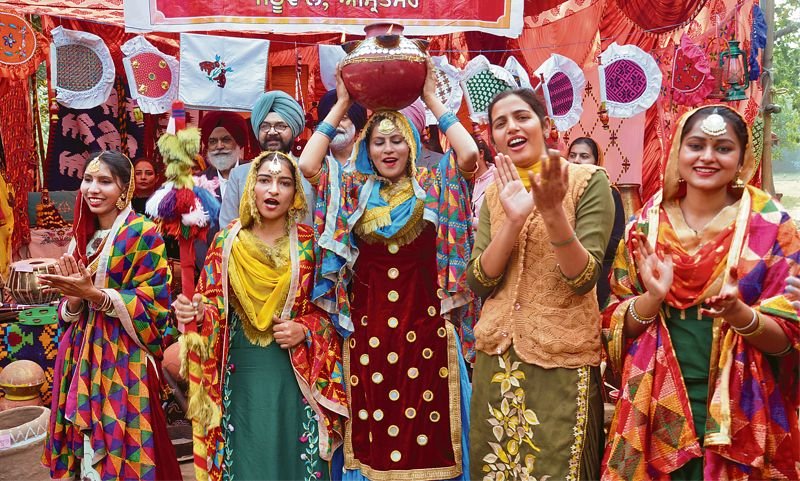Exploring the Vibrant Tapestry of Punjabi Culture
Punjab, a land steeped in history and brimming with diversity, boasts one of the most ancient and rich cultures in the world. Known as the "Land of Five Rivers," Punjab's culture encompasses a myriad of facets, including language, religion, traditional dress, architecture, handicrafts, and festivals. Let's embark on a journey to unravel the vibrant tapestry of Punjabi culture.
The Linguistic Melting Pot of Punjab
Punjabi, the official language of Punjab, is a treasure trove of words and expressions that reflect the region's cultural heritage. Derived from the fusion of Hindi, Persian, Urdu, and English, Punjabi is a tonal language with a script called Gurmukhi. It is spoken by millions of people worldwide, making it the ninth most widely spoken language on the planet.
Within Punjab, various dialects have emerged, shaped by the geographical and historical context of different regions. Bhattian, Malwai, Pahari, Doabi, Kangri, Hindko, Pothowari, Shahpuri, Rachnavi, Majhi, Thali, Thalochri, Chakwali, and Ghebi are just a few examples of the diverse dialects spoken across the state. Furthermore, Hindi and English are also widely understood and spoken in Punjab.
A Tapestry of Faiths: Religion in Punjab
Religion plays a significant role in shaping the cultural landscape of Punjab. Sikhism, founded by Guru Nanak Dev and subsequently developed by nine other Gurus, is the predominant religion in the region. Sikhs revere the Guru Granth Sahib, their holy scripture, and practice the core principles of hard work, selfless service, and devotion to the Almighty. The Golden Temple in Amritsar stands as a testament to the Sikh faith and attracts pilgrims from all corners of the globe.
Hinduism, too, holds a prominent place in Punjab's religious fabric. Hindus in Punjab lead a liberal lifestyle and often visit gurdwaras, Sikh places of worship, to pay their respects. Islam, Christianity, Jainism, and Buddhism also find their followers in Punjab, albeit in smaller numbers. The coexistence of multiple faiths in Punjab is a testament to the region's religious harmony and tolerance.
Dressing in Colorful Splendor: Traditional Attire of Punjab
Punjabi traditional attire is a feast for the eyes, reflecting the region's vibrant and diverse culture. For women, the quintessential outfit is the churidar kurta. This ensemble comprises a kameez, a loose shirt, paired with a salwar, a type of pant. Dupattas, colorful scarves, often complement the salwar kameez. Intricate phulkari embroidery, a signature craft of Punjab, adorns many traditional garments, adding an extra layer of beauty.
Men, on the other hand, opt for the classic kurta pajama, a long-sleeved shirt paired with loose-fitting pants. The turban, known as pagri or pugg, holds immense religious and cultural significance for Sikh men. It symbolizes honor, pride, and adherence to Sikh traditions. Jooti, traditional footwear adorned with exquisite designs, completes the ensemble for both men and women.
Architectural Marvels: Punjab's Rich Heritage
The architectural heritage of Punjab is a testament to the region's historical and cultural tapestry. While Sikhism, the dominant religion in Punjab, does not have a distinct architectural style, it draws inspiration from Islamic and Hindu architectural elements. Gurdwaras, the primary places of worship for Sikhs, showcase the fusion of these influences.
The Golden Temple, situated in the heart of Amritsar, stands as an architectural marvel. Its serene and ethereal presence mesmerizes visitors, with the shimmering golden facade reflecting in the sacred waters surrounding it. Another architectural gem is Chandigarh, the state capital, designed by renowned architect Le Corbusier. With its well-planned infrastructure and modernist design, Chandigarh exemplifies the harmonious fusion of functionality and aesthetics.
Celebrating the Artistic Spirit: Handicrafts of Punjab
Punjab's rich artistic traditions find expression in its exquisite handicrafts. Phulkari, a form of intricate embroidery, holds a special place in Punjab's artistic heritage. Skilled artisans create stunning patterns on fabric, showcasing the region's love for vibrant colors and intricate designs. Durries, handwoven rugs, and carpets, add warmth and beauty to homes across Punjab. The Thatheras of Jandiala Guru, known for their brass and copper craftsmanship, have even been recognized on the UNESCO List of Intangible Cultural Heritage.
Woodwork, pottery, and brassware are other notable handicrafts that showcase the artistic prowess of Punjabi artisans. These traditional crafts not only preserve the cultural heritage of Punjab but also provide a livelihood for numerous skilled craftsmen.
Festivals: A Kaleidoscope of Joy and Celebration
Punjab is known for its exuberant and joyous festivals that bring communities together in celebration. Baisakhi, marking the harvest season, holds immense significance for the agricultural community of Punjab. It is a time of rejoicing and gratitude for the abundant crops, with vibrant processions, music, and dance filling the streets.
Lohri, celebrated on the 13th of January, is a winter harvest festival that ushers in a sense of warmth and camaraderie. Bonfires, folk songs, and traditional dances mark this occasion, as people come together to celebrate the changing seasons.
Gurpurabs, commemorating the birthdays and martyrdoms of Sikh Gurus, are celebrated with great fervor throughout Punjab. The rhythmic beats of the dhol, the soul-stirring kirtans, and the recitation of holy verses fill the air as devotees gather in gurdwaras to pay their respects.
The Resilient Spirit of Punjab
Punjab's culture is a testament to the resilient spirit and indomitable zest for life displayed by its people. Despite the challenges faced throughout history, Punjab has managed to preserve its cultural heritage and pass it down through generations. The warmth, hospitality, and pride exhibited by Punjabis make them truly special.
As you immerse yourself in the vibrant tapestry of Punjabi culture, you cannot help but be captivated by its linguistic diversity, religious harmony, colorful attire, architectural marvels, exquisite handicrafts, and joyous festivals. Punjab's cultural legacy is a living testament to the richness and diversity of the human experience.
So, embrace the spirit of Punjab, celebrate its traditions, and delve into the vibrant tapestry of its cultural heritage. From the melodic sounds of Punjabi music to the tantalizing flavors of its cuisine, Punjab offers an experience that is both captivating and unforgettable. Discover the land of five rivers and let the essence of Punjabi culture envelop you in its warm embrace.

